
Холодильник— морозильник
CSK 35000
GB Instruction for use
RUS инструкция по эксплуатации


This appliance is not intended for use by person with reduced physical, sensory or mental
capabilities or lack of experience and knowledge unless they have been given supervision or
instruction concerning use of the appliance by a person responsible for their safety.
Children should be supervised to ensure that they do not play with the appliance.
Устройство не предназначено для использования людьми со сниженными физическими
или умственными способностями, а также нарушениями чувствительности. Люди, не
имеющие опыта обращения с данным устройством, могут использовать его только под
наблюдением опытных лиц, ответственных за безопасность.
Использование устройства детьми также должно происходить под контролем взрослых
WARNING!
In order to ensure a normal operation of your refrigerating appliance, which uses a
completely environmentally friendly refrigerant the R 600a (flammable only under
certain conditions) you must observe the folloving rules:
Do not hinder the free circulation of the air around the appliance.
Do not use mechanic devices in order to accelerate the defrosting, others than the
ones recommended by the manufacturer.
Do not destroy the refrigerating circuit.
Do not use electric appliances inside the food beeping compartment, others than
those that might have been reccommended by the manufacturer.
ВНИМАНИЕ
Для того, чтобы обеспечить нормальную работу Вашего холодильника в котором
используется охлаждающий реагент R 600a, совершенно безвредный для
окружающей среды (воспламеняющийся только в определенных условиях), Вам
следует соблюдать следующие правила.
Не создавайте препятствий для свободной циркуляции воздуха вокруг
холодильника.
Не пользуйтесь никакими механическими приспособлениями и инструментами
для удаления льда при размораживании холодильника, коме тех, которые
рекомендованы изготовителем.
Не допускайте повреждения охлаждающего контура.
Не устанавливайте внутрь холодильного отделения, где хранятся продукты,
никакие электрические устройства, кроме тех, которые рекомендованы
изготовителем.

Safety first /1
Electrical requirements /2
Transportation instructions /2
Installation instructions /2
Getting to know your appliance /3
Suggested arrangement of food in the appliance /3
Temperature control and adjustment /4
Before operating /4
Storing frozen food /4
Freezing fresh food /4
Making ice cubes /5
Defrosting /5
Replacing the interior light bulb /5
Cleaning and care /5
Repositioning the door /6
Do’s and don’ts /6
Information about operating noises /7
Trouble – shooting /8
Technical data /8
Безопасность прежде всего /9
Требования к электропитанию /10
Инструкция по транспортировке /10
Инструкция по установке /10
Общие сведения о холодильнике /11
Рекомендуемый способ размещения
продуктов в холодильнике /11
Регулировка температуры /12
Перед началом работы /12
Хранение замороженных продуктов /12
Замораживание свежих продуктов /12
Замораживание льда /13
Размораживание холодильника /13
Замена лампочки внутреннего освещения /13
Чистка холодильника и уход за ним /13
Перевешивание двери /14
Что следует и чего не следует делать /14
Почему холодильник шумит /15
Устранение неисправностей /16
Технические характеристики /17
GB Index
РУС Coдepжаниe

1

2
3 4
9
5
6
7
8
10

11

GB Instruction for use
Congratulations on your choice of a Quality
Appliance, designed to give you many years of service.
Safety first!
Do not connect your appliance to the electricity supply
until all packing and transit protectors have been
removed.
• Leave to stand for at least 4 hours before switching
on, to allow compressor oil to settle, if transported
horizontally.
• If you are discarding an old appliance with a lock or
latch fitted to the door, ensure that it is left in a safe
condition to prevent the entrapment of children.
• This appliance must only be used for its intended
purpose.
• Do not dispose of the appliance on a fire. Your
appliance contains non CFC substances in the
insulation which are flammable. We suggest you
contact your local authority for information on disposal
and available facilities.
• We do not recommend use of this appliance in an
unheated, cold room. (e.g. garage, conservatory,
annex, shed, out-house etc.)
To obtain the best possible performance and trouble
free operation from your appliance it is very important to
read these instructions carefully. Failure to observe
these instructions may invalidate your right to free
service during the guarantee period.
Please keep these instructions in a safe place for easy
reference.
1

GB Instruction for use
Electrical requirements
Before inserting the plug into the wall socket
make sure that the voltage and the frequency
shown in the rating plate inside the appliance
corresponds to your electricity supply.
We recommend that this appliance is
connected to the mains supply via a suitably
switched and fused socket in a readily
accessible position.
Warning! This appliance must be earthed.
Repairs to electrical equipment should only be
performed by a qualified technician. Incorrect
repairs carried out by an unqualified person
are carry risks that may have critical
consequences for the user of the appliance.
ATTENTION!
This appliance operates with R 600a which is
an environmental friendly but flammable gas.
During the transportation and fixing of the
product, care must be taken not to damage
the cooling system. If the cooling system is
damaged and there is a gas leakage from the
system, keep the product away from open
flame sources and ventilate the room for a
while.
WARNING — Do not use mechanical devices
or other means to accelerate the defrosting
process, others than those recommended by
the manufacturer.
WARNING — Do not damage the refrigerant
circuit.
WARNING — Do not use electrical appliances
inside the food storage compartments of the
appliance, unless they are of the type
recommended by the manufacturer.
Transportation instructions
1. The appliance should be transported only in
an upright position. The packing as supplied
must be intact during transportation.
2. If during the transport the appliance, has
been positioned horizontally, it must not be
operated for at least 4 hours, to allow the
system to settle.
3. Failure to comply with the above
instructions could result in damage to the
appliance, for which the manufacturer will not
be held liable.
4. The appliance must be protected against
rain, moisture and other atmospheric
influences.
Important!
• Care must be taken while cleaning/carrying
the appliance not to touch the bottom of the
condenser metal wires at the back of the
appliance, as this could cause injury to fingers
and hands.
• Do not attempt to sit or stand on top of your
appliance as it is not designed for such use.
You could injure yourself or damage the
appliance.
• Make sure that the mains cable is not caught
under the appliance during and after moving,
as this could damage the cable.
• Do not allow children to play with the
appliance or tamper with the controls.
Installation instructions
1. Do not keep your appliance in a room
where the temperature is likely to fall below 10
degrees C (50 degrees F) at night and/or
especially in winter, as it is designed to
operate in ambient temperatures between +10
and +32 degrees C (50 and 90 degrees F). At
lower temperatures the appliance may not
operate, resulting in a reduction in the storage
life of the food.
2. Do not place the appliance near cookers or
radiators or in direct sunlight, as this will
cause extra strain on the appliance’s
functions. If installed next to a source of heat
or freezer, maintain the following minimum
side clearances:
From Cookers 30 mm
From Radiators 300 mm
From Freezers 25 mm
3. Make sure that sufficient room is provided
around the appliance to ensure free air
circulation (Item 2).
• Put the back airing lid to the back of your
refrigerator to set the distance between the
refrigerator and the wall (Item 3).
2

GB Instruction for use
4. The appliance should be positioned on a
smooth surface. The two front feet can be
adjusted as required.To ensure that your
appliance is standing upright adjust the two
front feet by turning clockwise or anti-
clockwise, until firm contact is secured with
the floor. Correct adjustment of feet prevents
excessive vibration and noise (Item 4).
5. Refer to «Cleaning and Care» section to
prepare your appliance for use.
Getting to know your appliance
(Item 1)
1 — Thermostat and lamp housing
2 — Adjustable Cabinet shelves
3 — Water collector
4 — Crisper cover
5 — Crispers
6 — Ice tray support & ice tray
7 — Compartment for quickly freezing
8 — Compartments for frozen froods keeping
9 — Adjustable foot
10 — Dairy Compartment
11 — Shelf for jars
12 — Keeping cup
13 — Shelf for bottles
14 — Freezer fan
The timer is a device for automatic defrost.
After a certain time him activate the heaters
who produce the defrost of your refriferator.
The fan has the purpose to provide the
circulation of the air in compartment. It is
connected in parallel with the motor-
compressor. When the motor-compressor is
off, the fan will also be off.
Suggested arrangement of food in
the appliance
Guidelines for obtaining optimum storage and
hygiene:
1. The fridge compartment is for the short-
term storage of fresh food and drinks.
2. The freezer compartment is
rated and suitable for the freezing and
storage of pre-frozen food.
The recommendation for storage as
stated on the food packaging should be
observed at all times.
3. Dairy products should be stored in the
special compartment provided in the door
liner.
4. Cooked dishes should be stored in airtight
containers.
5. Fresh wrapped produce can be kept on
the shelf. Fresh fruit and vegetables should be
cleaned and stored in the crispers.
6. Bottles can be kept in the door section.
7. To store raw meat, wrap in polythene
bags and place on the lowest shelf. Do not
allow to come into contact with cooked food,
to avoid contamination. For safety, only store
raw meat for two to three days.
8. For maximum efficiency, the removable
shelves should not be covered with paper or
other materials to allow free circulation of cool
air.
9. Do not keep vegetable oil on door
shelves. Keep the food packed, wrapped or
covered. Allow hot food and beverages to cool
before refrigerating. Leftover canned food
should not be stored in the can.
10. Fizzy drinks should not be frozen and
products such as flavoured water ices should
not be consumed too cold.
11. Some fruit and vegetables suffer damage
if kept at temperatures near 0°C. Therefore
wra
inea
les, melons, cucumbers,
3

GB Instruction for use
Temperature control and adjustment
Operating temperatures are controlled by the
thermostat knob (Item 5) and may be set at
any position between 1 and 5 (the coldest
position).
The average temperature inside the fridge
should be around +5°C (+41°F).
Therefore adjust the thermostat to obtain the
desired temperature. Some sections of the
fridge may be cooler or warmer (such as
salad crisper and top part of the cabinet)
which is quite normal. We recommend that
you check the temperature periodically with a
thermometer to ensure that the cabinet is kept
to this temperature. Frequent door openings
cause internal temperatures to rise, so it is
advisable to close the door as soon as
possible after use.
Before operating
Final Check
Before you start using the appliance check
that:
1. The feet have been adjusted for perfect
levelling.
2. The interior is dry and air can circulate
freely at the rear.
3. The interior is clean as recommended
under «Cleaning and care.”
4. The plug has been inserted into the wall
socket and the electricity is switched on.
When the door is open the interior light will
come on.
And note that:
5. You will hear a noise as the compressor
starts up. The liquid and gases sealed within
the refrigeration system may also make some
(noise), whether the compressor is running or
not. This is quite normal.
6. Slight undulation of the top of the cabinet is
quite normal due to the manufacturing
process used; it is not a defect.
7. We recommend setting the thermostat knob
midway and monitor the temperature to
ensure the appliance maintains desired
storage temperatures (See section
Temperature Control and Adjustment).
8. Do not load the appliance immediately it is
switched on. Wait until the correct storage
temperature has been reached. We
recommend checking the temperature with an
accurate thermometer (see; Temperature
Control and Adjustment).
Storing frozen food
Your freezer is suitable for the long-term
storage of commercially frozen foods and also
can be used to freeze and store fresh food.
If there is a power failure, do not open the
door. Frozen food should not be affected if the
failure lasts for less than 16 hrs. If the failure
is longer, then the food should be checked
and either eaten immediately or cooked and
then re-frozen.
Freezing fresh food
Please observe the following instructions to
obtain the best results.
Do not freeze too large a quantity at any one
time. The quality of the food is best preserved
when it is frozen right through to the core as
quickly as possible.
Do not exceed the freezing capacity of your
appliance in 24 h.
Placing warm food into the freezer
compartment causes the refrigeration
machine to operate continously until the food
is frozen solid. This can temporarily lead to
excessive cooling of the refrigeration
compartment.
When freezing fresh food, keep the
thermostat knob at medium position. Small
quantities of food up to 1/2 kg. (1 lb) can be
frozen without adjusting the temperature
control knob.
Take special care not to mix already frozen
food and fresh food.
4

GB Instruction for use
Making ice cubes
Fill the ice — cube tray 3/4 full with water and place
it in the freezer. Loosen frozen trays with a spoon
handle or a similar implement; never use sharp-
edged objects such as knives or forks.
Defrosting
A) Fridge compartment
The fridge compartment defrosts automatically.
The defrost water runs to the drain tube via a
collection container at the back of the appliance
(Item 6).
During defrosting, water droplets may form at the
back of the fridge compartment where a
concealed evaporator is located. Some droplets
may remain on the liner and refreeze when
defrosting is completed. Do not use pointed or
sharp-edged objects such as knives or forks to
remove the droplets which have refrozen.
If, at any time, the defrost water does not drain
from the collection channel, check that no food
particles have blocked the drain tube. The drain
tube can be cleared with a pipe-cleaner or similar
implement.
Check that the tube is permanently placed with its
end in the collecting tray on the compressor to
prevent the water spilling on the electric installation
or on the floor (Item 7).
B) Freezer compartment
Defrosting is very straightforward and without
mess, thanks to a special defrost collection basin.
Defrost twice a year or when a frost layer of
around 7 (1/4″) mm has formed. To start the
defrosting procedure, switch off the appliance at
the socket outlet and pull out the mains plug.
All food should be wrapped in several layers of
newspaper and stored in a cool place (e.g. fridge
or larder).
Containers of warm water may be placed carefully
in the freezer to speed up the defrosting.
Do not use pointed or sharp-edged objects,
such as knives or forks to remove the frost.
Never use hairdryers, electrical heaters or other
such electrical appliances for defrosting.
Sponge out the defrost water collected in the
bottom of the freezer compartment. After
defrosting, dry the interior thoroughly (Item 8 & 9).
Insert the plug into the wall socket and switch on
the electricity supply.
Replacing the interior light bulb
Should the light fail, switch off at the socket
outlet and pull out the mains plug.
5
Then ensure the bulb is screwed securely in
the bulb holder. Replace the plug and
switch on.
If the light still fails, obtain a replacement
E14 screw-cap type 15 Watt (Max) bulb
from your local electrical store and then fit it
(Item 10).
Carefully dispose of the burnt-out light bulb
immediately.
Cleaning and care
1. We recommend that you switch off the
appliance at the socket outlet and pull out
the mains plug before cleaning.
2. Never use any sharp instruments or
abrasive substances, soap, household
cleaner, detergent or wax polish for
cleaning.
3. Use luke warm water to clean the
cabinet of the appliance and wipe it dry.
4. Use a damp cloth wrung out in a
solution of one teaspoon of bicarbonate of
soda to one pint of water to clean the
interior and wipe it dry.
5. Make sure that no water enters the
temperature control box.
6. If the appliance is not going to be used
for a long period of time, switch it off,
remove all food, clean it and leave the door
ajar.
7. We recommend that you polish the
metal parts of the product (i.e. door exterior,
cabinet sides) with a silicone wax (car
polish) to protect the high quality paint
finish.
8. Any dust that gathers on the condenser,
which is located at the back of the
appliance, should be removed once a year
with a vacuum cleaner.
9. Check door seals regularly to ensure
they areclean and free from food particles.
10. Never:
• Clean the appliance with unsuitable
material; eg petroleum based products.
• Subject it to high temperatures in any way,
• Scour, rub etc., with abrasive material.

GB Instruction for use
11. Removal of dairy cover and door tray :
• To remove the dairy cover, first lift the cover
up by about an inch and pull it off from the
side where there is an opening on the cover.
• To remove a door tray, remove all the
contents and then simply push the door tray
upwards from the base.
12. Make sure that the special plastic
container at the back of the appliance which
collects defrost water is clean at all times. If
you want to remove the tray to clean it, follow
the instructions below:
• Switch off at the socket outlet and pull out
the mains plug
• Gently uncrimp the stud on the compressor,
using a pair of pliers, so that the tray can be
removed
• Lift it up.
• Clean and wipe it dry
• Reassemble, reversing the sequence and
operations
13. To remove a drawer, pull it as far as
possible, tilt it upwards and then pull it out
completely.
Repositioning the door
Proceed in numerical order (Item 11).
Do’s and don’ts
Do- Clean and defrost your appliance
regularly (See «Defrosting»)
Do- Keep raw meat and poultry below
cooked food and dairy products.
Do- Take off any unusable leaves on
vegetables and wipe off any soil.
Do- Leave lettuce, cabbage, parsley and
cauliflower on the stem.
Do- Wrap cheese firstly in greaseproof paper
and then in a polythene bag, excluding
as much air as possible. For best results,
take out of the fridge compartment an
hour before eating.
Do- Wrap raw meat and poultry loosely in
polythene or aluminium foil. This
prevents drying.
Do- Wrap fish and offal in polythene bags.
Do- Wrap food with a strong odour or which
may dry out, in polythene bags, or
aluminium foil or place in airtight
container.
Do- Wrap bread well to keep it fresh.
Do- Chill white wines, beer, lager and mineral
water before serving.
Do- Check contents of the freezer every so
often.
Do- Keep food for as short a time as possible
and adhere to «Best Before» and «Use
by» etc. dates.
Do- Store commercially frozen food in
accordance with the instructions given on
the packets.
Do- Always choose high quality fresh food
and be sure it is thoroughly clean before
you freeze it.
Do- Prepare fresh food for freezing in small
portions to ensure rapid freezing.
Do- Wrap all food in aluminium foil or freezer
quality polythene bags and make sure
any air is excluded.
Do- Wrap frozen food immediately after
purchasing and put it in to the freezer as
soon as possible.
Do- Defrost food in the fridge compartment.
6

Don’t- Store bananas in your fridge
compartment.
Don’t- Store melon in your fridge. It can be
chilled for short periods as long as it
is wrapped to prevent it flavouring
other food.
Don’t- Cover the shelves with any protective
materials which may obstruct air
circulation.
Don’t- Store poisonous or any dangerous
substances in your appliance. It has
been designed for the storage of
edible foodstuffs only.
Don’t- Consume food which has been
refrigerated for an excessive length of
time.
Don’t- Store cooked and fresh food together
in the same container. They should
be packaged and stored separately.
Don’t- Let defrosting food or food juices drip
onto food.
Don’t- Leave the door open for long periods,
as this will make the appliance more
costly to run and cause excessive ice
formation.
Don’t- Use sharp edged objects such as
knives or forks to remove the ice.
Don’t- Put hot food into the appliance. Let it
cool down first.
Don’t- Put liquid-filled bottles or sealed cans
containing carbonated liquids into the
freezer, as they may burst.
Don’t- Exceed the maximum freezing loads
when freezing fresh food.
Don’t- Give children ice-cream and water
ices direct from the freezer. The low
temperature may cause ‘freezer
burns’ on lips.
Don’t- Freeze fizzy drinks.
Don’t- Try to keep frozen food which has
thawed; it should be eaten within 24
hours or cooked and refrozen.
Don’t- Remove items from the freezer with
wet hands.
GB Instruction for use
7
Information about operating noises
To keep the selected temperature constant,
your appliance occasionally switches ON the
compressor.
The resulting noises are quite normal.
As soon as the appliance has reached the
operating temperature, the noises
automatically reduce in volume.
The humming noise is emitted by the motor
(compressor). When the motor switches ON,
the noise may briefly increase in volume.
An sudden click can be heares some times
due to the timer changing position
The bubbling, gurgling or whirring noise is
emitted by the refrigerant as it flows through
the pipes.
The clicking noise can always be heard when
the thermostat switches ON/OFF the motor.
A clicking noise may occur when
— the automatic defrosting system is active.
— the appliance is cooling down or warming up
(material expansion).
If these noises are excessively loud, the
causes are probably not serious and are
usually very easy to eliminate.
— The appliance is not level — Use the height-
adjustable feet or place packing under the
feet.
— The appliance is not free-standing — Please
move the appliance away from kitchen units
or other appliances.
— Drawers, baskets or shelves are loose or
stick — Please check the detachable
components and, if required, refit them.
— Bottles and/or receptacles are touching each
other — Please move bottles and/or
receptacles away from each other.

Technical data
Brand
Appliance type
COMBI
Total gross volume (l.) 350
Total usable volume (l.) 294
Freezer usable volume (l.) 90
Refrigerator useful volume 204
Freezing capacity (kg/24 h) 8
Energy class (1) A
Power consumption (kWh/year) (2) 331
Autonomy (h) 20
Noise [dB(A) re 1 pW] 41
Ecological refrigerating agent R600a
(1) Energy class : A . . . G (A = economical . . . G = less economical)
(2) The real power consumption depends on using conditions and appliance location.
Trouble — shooting
If the appliance does not operate when
switched on, check;
• That the plug is inserted properly in the
socket and that the power supply is on. (To
check the power supply to the socket, plug
in another appliance)
• Whether the fuse has blown/circuit breaker
has tripped/main distribution switch has
been turned off.
• That the temperature control has been set
correctly.
• That the new plug is wired correctly, if you
have changed the fitted, moulded plug.
If the appliance is still not operating at all after
above checks, contact the dealer from whom
you purchased the unit.
Please ensure that above checks have been
done, as a charge will be made if no fault is
found.
GB Instruction for use
8

RUS Инструкция по эксплуатации
Поздравляем Вас с покупкой высококачественного
холодильника , который будет служить Вам долгое
время.
Безопасность прежде всего!
Не включайте холодильник в электросеть до тех пор, пока не
удалите всю упаковку и транспортировочные крепления.
• Если Вы перевозили холодильник в горизонтальном
положении, не включайте его после распаковки по крайней
мере 4 часа для того, чтобы все системы пришли в норму.
• Если Вы выбрасываете старый холодильник, и у него на
двери есть замок или задвижка, убедитесь, что они в
исправном состоянии, чтобы дети, играя, случайно не
оказались в нем запертыми.
• Холодильник должен использоваться только по назначению,
т. е. для замораживания и хранения пищевых продуктов в
домашних условиях.
• Не пытайтесь уничтожить старый холодильник, сжигая его.
В теплоизоляции холодильника используются горючие
материалы. Мы советуем Вам связаться с местными
органами власти для получения информации относительно
того, куда можно выбросить старый холодильник.
• Мы не рекомендуем пользоваться холодильником в не
отапливаемом, холодном месте (например, в гараже, на
складе, в пристройке, под навесом, в надворной постройке и
т.п.).
Чтобы обеспечить максимально эффективную и
бесперебойную работу холодильника, очень важно
внимательно прочитать эту инструкцию. Поломка
холодильника в результате несоблюдения наших
рекомендаций может лишить Вас права на бесплатное
обслуживание в течение гарантийного периода.
Пожалуйста, храните эту инструкцию в надежном месте,
чтобы ее легко можно было найти в случае необходимости.
9

RUS Инструкция по эксплуатации
Требования к электропитанию
Перед тем как вставить штепсель в
электрическую розетку, убедитесь, что
напряжение и частота тока, указанные на
заводской марке внутри холодильника,
соответствуют напряжению и частоте тока
в электросети Вашего дома.
Мы рекомендуем подключать холодильник к
электросети через розетку, должным
образом установленную в легко доступном
месте.
Внимание! Холодильник должен быть
заземлен
Ремонт электрического оборудования
должен выполняться только
квалифицированным специалистом.
Неправильный ремонт, выполненный
неквалифицированным человеком,
сопряжен с риском, и холодильник может
стать опасным в эксплуатации.
ВНИМАНИЕ – В холодильнике
используется охлаждающий реагент
R600a, который не наносит вреда
окружающей среде, но легко
воспламеняется. Во время
транспортировки и установки холодильника
следите за тем, чтобы не повредить
систему охлаждения. Если она оказалась
поврежденной, и имеется утечка
охлаждающего реагента, уберите от
холодильника источники открытого огня и
проветрите помещение.
ВНИМАНИЕ – Не пользуйтесь никакими
механическими приспособлениями, кроме
тех, что рекомендуются в настоящей
инструкции, для ускорения
размораживания холодильника и очистки
морозильной камеры от льда.
ВНИМАНИЕ – Не допускайте повреждения
системы охлаждения.
ВНИМАНИЕ – Не устанавливайте внутри
холодильника электрические
приспособления кроме тех, которые
рекомендованы изготовителем
холодильника.
Инструкция по транспортировке
1. Холодильник должен транспортироваться
только в вертикальном положении.
Заводская упаковка при транспортировке не
должна быть повреждена.
2. Если во время транспортировки
холодильник был помещен горизонтально,
им не следует пользоваться, по крайней
мере, 4 часа для того, чтобы все его
системы пришли в норму.
3. Изготовитель не несет ответственности
за повреждение холодильника, если
нарушаются вышеупомянутые
рекомендации.
4. Холодильник должен быть защищен от
дождя, влажности и других атмосферных
воздействий.
Важное замечание!
• Передвигая холодильник с места на
место, берегите руки. Старайтесь не
касаться металлических частей
конденсатора в задней части
холодильника. Вы можете повредить руки.
• Не садитесь и не вставайте на
холодильник. Он для этого не
предназначен. Вы можете получить
травму или повредить холодильник.
• Убедитесь, что электрический провод не
попал под холодильник во время и после
перемещения холодильника, иначе его
можно повредить.
• Не позволяйте детям играть с
холодильником или баловаться с ручками
и кнопками управления.
Инструкция по установке
1. Не ставьте холодильник в помещение,
в котором температура может опускаться
ниже 10 °C ночью или, в особенности
зимой, поскольку холодильник рассчитан
на работу при температуре окружающей
среды в пределах от +10 до +32 °C. При
более низкой температуре холодильник
может не работать, и срок хранения
продуктов в нем должен быть сокращен.
2. Не устанавливайте холодильник вблизи
кухонных плит или радиаторов отопления,
или в прямом солнечном свете, поскольку
это вызовет дополнительную нагрузку на
10

RUS Инструкция по эксплуатации
агрегаты холодильника. Если Вы
вынуждены устанавливать холодильник
рядом с источником тепла или
морозильником, обеспечьте следующее
минимальное расстояние:
от кухонных плит 30 мм
от радиаторов отопления 300 мм
от морозильников 25 мм
3. Для эффективной работы
холодильника между ним и стеной должно
оставаться пространство, достаточное для
свободной циркуляции воздуха. (рис. 2).
• Укрепите на задней стенке холодильника
ограничительную вентиляционную
решетку, чтобы холодильник стоял на
нужном расстоянии от стены (рис. 3).
4. Холодильник должен стоять на гладкой
поверхности. Две передние ножки должны
быть соответствующим образом
отрегулированы. Чтобы добиться строго
вертикального положения холодильника,
отрегулируйте ножки, вращая их по
часовой или против часовой стрелки, пока
они не будут устойчиво стоять на полу.
Правильная регулировка ножек
холодильника предотвращает чрезмерную
вибрацию и шум (рис. 4).
5. Обратитесь к разделу “Чистка
холодильника и уход за ним”, чтобы
подготовить холодильник к эксплуатации.
Общие сведения о холодильнике
(Рис. 1)
1. Термостат и блок внутреннего
освещения
2. Регулируемые полки
3. Поддон для сбора воды
4. Крышка ящика для овощей
5. Ящик для овощей
6. Полка и контейнер для льда
7. Отделение для быстрой заморозки
8. Отделение для хранения заморо
енных
продуктов
9. Передние регулируемые ножки
10. Отделение для молочных продуктов
11. Полка для банок
12. Дополнительные емкости (модели CHA
30000)
13. Полка для бутылок
14. Вентилятор морозильного отделения
Рекомендуемый способ
размещения продуктов в
холодильнике
Рекомендации по оптимальному хранению
и соблюдению санитарных норм:
1. Холодильное отделение
предназначено для непродолжительного
хранения свежих продуктов и напитков.
2. Морозильная камера имеет
замораживающую способность в три
звездочки и предназначена для хранения
замороженных продуктов. Рекомендации
по хранению замороженных продуктов
указаны на их упаковке и их следует
соблюдать во всех случаях.
3. Молочные продукты должны храниться
в специальном отделении на внутренней
стороне двери.
4. Приготовленные блюда должны
храниться в плотно закрытой посуде.
5. Свежие продукты в упаковке можно
хранить на полке. Свежие фрукты и овощи
должны быть чистыми и храниться в ящике
для овощей.
6. Бутылки можно хранить в специальном
отделении на двери.
7. Сырое мясо храните в полиэтиленовых
пакетах и на самой низкой полке. Не
допускайте контакта сырого мяса с
готовыми блюдами, чтобы избежать
заражения. В целях безопасности храните
сырое мясо только два—три дня.
8. Для максимально эффективной работы
холодильника, съемные полки не должны
быть накрыты бумагой или другими
материалами, препятствующими
свободной циркуляции холодного воздуха.
9. Не держите растительное масло на
полках с внутренней стороны двери.
Остужайте горячие продукты и напитки
перед тем, как ставить их в холодильник.
Открытые консервы не должны храниться в
консервных банках.
11
10. Нельзя замораживать газированные
напитки, а лед из ароматизированной воды
не следует употреблять слишком
холодным.

RUS Инструкция по эксплуатации
11. Некоторые фрукты и овощи портятся от
температуры, близкой к 0°С., поэтому
держите ананасы, дыню, огурцы, помидоры
и другие подобные продукты в
полиэтиленовых пакетах.
Регулировка температуры
Температура внутри холодильника
регулируется ручкой термостата, которая
может быть установлена в положение от 1
до 5 (самая низкая температура).
Средняя температура внутри холодильного
отделения должна быть +5 °C.
Поэтому, установите ручку термостата в
положение, которое обеспечит нужную
температуру. В разных местах внутри
холодильного отделения (например, ящика
для овощей или в верхней части
отделения) температура может быть выше
или ниже, что вполне нормально. Мы
советуем Вам периодически проверять
термометром, сохраняется ли внутри
холодильника нужная температура.
При частом открывании двери холодный
воздух выходит из холодильника и
температура внутри него повышается,
поэтому не оставляйте дверь
холодильника открытой и старайтесь
закрывать ее как можно быстрее.
4. Штепсель должен быть вставлен в
розетку и электричество включено. Когда
открывается дверца холодильного
отделения, должна загораться лампочка
внутреннего освещения.
И обратите внимание на то, что:
5. Вы будете слышать шум при включении
компрессора. Жидкость и газ внутри
системы охлаждения также могут
создавать некоторый шум, независимо от
того, работает компрессор или нет. Это
вполне нормально.
6. Небольшая неровность верхней
поверхности корпуса не является
дефектом: она есть результат
особенностей производства.
7. Мы советуем установить ручку
термостата в среднее положение и
проследить за температурой внутри
холодильника (см. Регулировка
температуры).
8. Не загружайте холодильник сразу же
после включения. Подождите, пока внутри
не установится нужная температура. Мы
советуем проверять температуру с
помощью точного термометра (см.
Регулировка температуры).
Хранение замороженных
продуктов
Холодильник рассчитан на длительное
хранение пищевых продуктов,
замороженных промышленным способом,
а также может быть использован для
замораживания и хранения свежих
продуктов.
В случае перебоев с электропитанием, не
открывайте дверь холодильника.
Замороженные продукты не пострадают,
если электропитание прервано менее чем
на 16 часов. Если электричества нет более
длительное время, то следует проверить
хранимые продукты и немедленно
использовать их или проварить и
заморозить заново.
Последняя проверка
Перед началом эксплуатации
холодильника проверьте следующее:
1. Передние ножки должны быть
отрегулированы так, чтобы обеспечивать
устойчивое положение холодильника.
2. Внутри холодильника должно быть сухо,
и воздух за ним должен циркулировать
свободно.
3. Холодильник внутри должен быть чисто
вымыт, как рекомендуется в разделе
“Чистка холодильника и уход за ним”.
Перед началом работы
12

RUS Инструкция по эксплуатации
Замораживание свежих
продуктов
Пожалуйста, соблюдайте приведенные ниже
рекомендации, для получения наилучших
результатов.
Не замораживайте продукты сразу в слишком
большом количестве за один раз. Продукты
лучше сохраняются, если они проморожены
насквозь максимально быстро.
Не перегружайте морозильную камеру более,
чем на сутки.
Если поместить в морозильную камеру теплые
продукты, то агрегаты холодильника должны
будут работать непрерывно, пока продукты не
заморозятся. На какое—то время это приведет к
чрезмерному понижению температуры в
холодильном отделении.
Для замораживания свежих продуктов,
установите ручку термостата в среднее
положение. Небольшие порции продуктов (до
0,5 кг) можно замораживать без переустановки
температуры.Особенно тщательно следите за
тем, чтобы не хранить вместе замороженные и
свежие продукты.
Замораживание льда
Заполните лоток для льда водой на 3/4 и
поместите его в морозильное отделение.
Вытаскивайте кубики льда ручкой ложки или
другим подобным инструментом; никогда не
пользуйтесь острыми или режущими
предметами вроде ножей или вилок.
Размораживание
A) Холодильное отделение
Холодильное отделение размораживается
автоматически. Талая вода стекает к
дренажной трубке через накопительный
контейнер в задней части холодильника (рис.
6).
При размораживании капли воды могут
скапливаться в задней части холодильного
отделения, где размещен скрытый испаритель.
Они могут остаться на стенке испарителя и
повторно замерзнуть, когда закончится
размораживание. Не удаляйте замерзшие
капли острыми или режущими предметами типа
ножей или вилок.
Если в какой—то момент Вы обнаружите, что
талая вода не вытекает из накопительного
контейнера, проверьте, не засорилась ли
дренажная трубка в результате попадания
частиц продуктов.
Дренажную трубку можно продуть какимлибо
приспособлением для прочистки.
Убедитесь, что конечная часть дренажной
трубки помещена в лоток для сбора воды на
компрессоре, во избежание попадания воды на
электрические части или на пол (рис 7).
B) Морозильная камера
Морозильная камера размораживается крайне
просто и без всяких хлопот, благодаря наличию
специального поддона для сбора талой воды.
Размораживайте камеру два раза в год или
тогда, когда накопится слой инея толщиной до 7
мм. Чтобы начать размораживание, выключите
холодильник из сети, вытащив штепсель из
электрической розетки.
Все продукты следует завернуть в несколько
слоев бумаги и сложить в прохладном месте
(например холодильнике или кладовке).
Для того, чтобы ускорить размораживание, Вы
можете осторожно поставить в морозильную
камеру емкость с теплой водой.
Не пользуйтесь острыми или режущими
предметами вроде ножей или вилок для того,
чтобы удалить иней.
Никогда не пользуйтесь феном, электрическим
нагревателем или какимлибо другим аналогичным
электрическим прибором для размораживания.
Удалите губкой талую воду, собравшуюся на
дне морозильной камеры. После
размораживания насухо вытрите внутреннюю
поверхность камеры. (Рис 8 и 9). Вставьте
штепсель в розетку и включите холодильник.
Замена лампочки внутреннего
освещения
Если свет внутри холодильника не горит,
выключите выключатель, расположенный около
лампочки и отключите холодильник от сети.
Затем проверьте, надежно ли завинчена в
патроне лампочка. Подключите холодильник к
электросети и включите его.
Если свет внутри холодильника по—прежнему не
горит, купите в магазине новую лампочку типа
E14 (завинчивающуюся) мощностью 15 Вт и
установите ее на место (рис. 10).
Перегоревшую лампочку незамедлительно
выбросьте, соблюдая меры предосторожности.
13
/
Инструкцию для Beko CSK 35000 на русском языке, в формате pdf можно скачать с нашего сайта. Наш каталог предоставляем Вам инструкцию производителя фирмы Beko, которая была взята из открытых источников. Ознакомившись с руководством по эксплуатации от Beko, Вы на все 100% и правильно сможете воспользоваться всеми функциями устройства.
Для сохранения инструкции «Холодильник Beko CSK 35000» на русском языке на вашем компьютере либо телефоне, нажмите кнопку «Скачать инструкцию». Если активна кнопка «Инструкция онлайн», то Вы можете просмотреть документ (manual), в своём браузере онлайн.
Если у Вас нет возможности скачать инструкцию по эксплуатации либо просмотреть её, Вы можете поделиться ссылкой на эту страницу в социальных сетях и при удобном моменте скачать инструкцию. Либо добавьте эту страницу в закладки Вашего браузера, нажав кнопку «Добавить страницу в закладки браузера».
Have a look at the manual Beko Csk 35000 Instruction For Use online for free. It’s possible to download the document as PDF or print. UserManuals.tech offer 187 Beko manuals and user’s guides for free. Share the user manual or guide on Facebook, Twitter or Google+.

Холодильник- морозильник
CSK 35000
GB I n s t r u c t i o n f o r u s e
RUS инструкция по эксплуатации


This appliance is not intended for use by person with reduced physical, sensory or mental capabilities or lack of experience and knowledge unless they have been given supervision or instruction concerning use of the appliance by a person responsible for their safety. Children should be supervised to ensure that they do not play with the appliance. Устройство не предназначено для использования людьми со сниженными физическими или умственными способностями , а также нарушениями чувствительности . Люди, не имеющие опыта обращения с данным устройством , могут использовать его только под наблюдением опытных лиц , ответственных за безопасность . Использованиеустройствадетьмитакжедолжнопроисходитьподконтролемвзрослых. WARNING! In order to ensure a normal op eration of your refrigerating appliance, which uses a completely environmentally friendly refr igerant the R 600a (flammable only under certain conditions) you must observe the folloving rules: Š Do not hinder the free circulation of the air around the appliance. Š Do not use mechanic devices in order to accelerate the defrosting, others than the ones recommended by the manufacturer. Š Do not destroy the refrigerating circuit. Š Do not use electric appliances inside the food beeping compartment, others than those that might have been recco mmended by the manufacturer. ВНИМАНИЕ Для того, чтобы обеспечить нормальную работу Вашего холодильника в котором используется охлаждающий реагент R 600a, совершенно безвредный для окружающей среды (воспламеняющийся только в определенных условиях ), Вам следует соблюдать следующие правила . Š Не создавайте препятствий для свободной циркуляции воздуха вокруг холодильника . Š Не пользуйтесь никакими механическими приспособлениями и инструментами для удаления льда при размораживании холодильника , коме тех , которые рекомендованы изготовителем . Š Не допускайте повреждения охлаждающего контура. Š Не устанавливайте внутрь холодильного отделения , где хранятся продукты , никакие электрические устройства , кроме тех, которые рекомендованы изготовителем .

Safety first /1
Electrical requirements /2
Transportation instructions /2
Installation instructions /2
Getting to know your appliance /3
Suggested arrangement of food in the appliance /3
Temperature control and adjustment /4
Before operating /4
Storing frozen food /4
Freezing fresh food /4
Making ice cubes /5
Defrosting /5
Replacing the interior light bulb /5
Cleaning and care /5
Repositioning the door /6
Do’s and don’ts /6
Information about operating noises /7
Trouble – shooting /8
Technical data /8
Безопасность прежде всего /9
Требования к электропитанию /10
Инструкция по транспортировке /10
Инструкция по установке /10
Общие сведения о холодильнике /11
Рекомендуемый способ размещения
продуктов в холодильнике /11
Регулировка температуры /12
Перед началом работы /12
Хранение замороженных продуктов /12
Замораживание свежих продуктов /12
Замораживание льда /13
Размораживание холодильника /13
Замена лампочки внутреннего освещения /13
Чистка холодильника и уход за ним /13
Перевешивание двери /14
Что следует и чего не следует делать /14
Почему холодильник шумит /15
Устранение неисправностей /16
Технические характеристики /17
GB Index
РУС Co дepжани e




GB Instruction for use Congratulations on your choice of a Quality Appliance, designed to give y ou many years of service. Safety first! Do not connect your appliance to the electricity supply until all packing and transit protectors have been removed. • Leave to stand for at leas t 4 hours before switching on, to allow compressor oil to settle, if transported horizontally. • If you are discarding an old appliance with a lock or latch fitted to the door, ensure that it is left in a safe condition to prevent the entrapment of children. • This appliance must only be used for its intended purpose. • Do not dispose of the appliance on a fire. Your appliance contains non CFC substances in the insulation which are flammable. We suggest you contact your local authority for information on disposal and available facilities. • We do not recommend use of this appliance in an unheated, cold room. (e.g . garage, conservatory, annex, shed, out-house etc.) To obtain the best possi ble performance and trouble free operation from your applianc e it is very important to read these instructions care fully. Failure to observe these instructions may invalidate your right to free service during the guarantee period. Please keep these instructions in a safe place for easy reference. 1

GB Instruction for use Electrical requirements Before inserting the plug into the wall socket make sure that the voltage and the frequency shown in the rating plate inside the appliance corresponds to your electricity supply. We recommend that this appliance is connected to the mains supply via a suitably switched and fused socket in a readily accessible position. Warning! This appliance must be earthed. Repairs to electrical equipment should only be performed by a qualified technician. Incorrect repairs carried out by an unqualified person are carry risks that may have critical consequences for the us er of the appliance. ATTENTION! This appliance operates with R 600a which is an environmental friendly but flammable gas. During the transportation and fixing of the product, care must be taken not to damage the cooling system. If the cooling system is damaged and there is a gas leakage from the system, keep the product away from open flame sources and ventilate the room for a while. WARNING - Do not use mechanical devices or other means to accelerate the defrosting process, others than those recommended by the manufacturer. WARNING - Do not damage the refrigerant circuit. WARNING - Do not use electrical appliances inside the food storage compartments of the appliance, unless they are of the type recommended by the manufacturer. Transportation instructions 1. The appliance should be transported only in an upright position. The packing as supplied must be intact during transportation. 2. If during the trans port the appliance, has been positioned horizontally, it must not be operated for at least 4 hours, to allow the system to settle. 3. Failure to comply with the above instructions could result in damage to the appliance, for which the manufacturer will not be held liable. 4. The appliance must be protected against rain, moisture and other atmospheric influences. Important! • Care must be taken while cleaning/carrying the appliance not to touch the bottom of the condenser metal wires at the back of the appliance, as this could cause injury to fingers and hands. • Do not attempt to sit or stand on top of your appliance as it is not designed for such use. You could injure yourself or damage the appliance. • Make sure that the mains cable is not caught under the appliance during and after moving, as this could damage the cable. • Do not allow children to play with the appliance or tamper with the controls. Installation instructions 1. Do not keep your appliance in a room where the temperature is likely to fall below 10 degrees C (50 degrees F) at night and/or especially in winter, as it is designed to operate in ambient tem peratures between +10 and +32 degrees C (50 and 90 degrees F). At lower temperatures the appliance may not operate, resulting in a reduction in the storage life of the food. 2. Do not place the app liance near cookers or radiators or in direct sunlight, as this will cause extra strain on the appliances functions. If installed next to a source of heat or freezer, maintain the following minimum side clearances: From Cookers 30 mm From Radiators 300 mm From Freezers 25 mm 3. Make sure that suffi cient room is provided around the appliance to ensure free air circulation (Item 2). • Put the back airing lid to the back of your refrigerator to set t he distance between the refrigerator and the wall (Item 3). 2

GB Instruction for use 4. The appliance should be positioned on a smooth surface. The two front feet can be adjusted as required.To ensure that your appliance is standing upr ight adjust the two front feet by turning clockwise or anti- clockwise, until firm contact is secured with the floor. Correct adjustment of feet prevents excessive vibration and noise (Item 4). 5. Refer to Cleaning and Care section to prepare your appliance for use. Getting to know your appliance (Item 1) 1 - Thermostat and lamp housing 2 - Adjustable Cabinet shelves 3 - Water collector 4 - Crisper cover 5 - Crispers 6 - Ice tray support & ice tray 7 - Compartment for quickly freezing 8 - Compartments fo r frozen froods keeping 9 - Adjustable foot 10 - Dairy Compartment 11 - Shelf for jars 12 - Keeping cup 13 - Shelf for bottles 14 - Freezer fan The timer is a device for automatic defrost. After a certain time him activate the heaters who produce the defrost of your refriferator. The fan has the purpose to provide the circulation of the air in compartment. It is connected in parallel with the motor- compressor. When the motor-compressor is off, the fan will also be off. Suggested arrangement of food in the appliance Guidelines for obtaining optimum storage and hygiene: 1. The fridge compar tment is for the short- term storage of fresh food and drinks. 2. The freezer compartment is rated and suitable for the freezing and storage of pre-frozen food. The recommendation for storage as stated on the food packaging should be observed at all times. 3. Dairy products should be stored in the special compartment pr ovided in the door liner. 4. Cooked dishes should be stored in airtight containers. 5. Fresh wrapped produce can be kept on the shelf. Fresh fruit and vegetables should be cleaned and stored in the crispers. 6. Bottles can be kept in the door section. 7. To store raw meat, wrap in polythene bags and place on the lowest shelf. Do not allow to come into contact with cooked food, to avoid contamination. For safety, only store raw meat for two to three days. 8. For maximum efficiency, the removable shelves should not be covered with paper or other materials to allow free circulation of cool air. 9. Do not keep vegetable oil on door shelves. Keep the food packed, wrapped or covered. Allow hot food and beverages to cool before refrigerating. Leftover canned food should not be stored in the can. 10. Fizzy drinks should not be frozen and products such as flavoured water ices should not be consumed too cold. 11. Some fruit and vegetables suffer damage if kept at temperatur es near 0°C. Therefore wra p pineapples, melons, cucumbers, 3
All Beko manuals
Comments (0)
Related Manuals for Beko Csk 35000 Instruction For Use

Размеры 200*54*60 см, Общий объем 350 л, количество камер 2, тип управления — механическое, цвет белый.
Подробнее
Цена действительна только для интернет-магазина и может отличаться от цен в розничных магазинах
- Описание
- Отзывы
- Задать вопрос
-
Дополнительно
Описание
Технические характеристики
Производитель Beko
Размеры (В*Ш*Г) 200*54*60 см
Общий объем 350 л
Количество камер 2
Тип управления механическое
Цвет белый
Характеристики
|
Цвет |
Белый |
|
Тип управления |
программируемый |
Документы
Задать вопрос
Вы можете задать любой интересующий вас вопрос по товару или работе магазина.
Наши квалифицированные специалисты обязательно вам помогут.
Задать вопрос
Дополнительно
Дополнительная вкладка, для размещения информации о магазине, доставке или любого другого важного контента. Поможет вам ответить на интересующие покупателя вопросы и развеять его сомнения в покупке. Используйте её по своему усмотрению.
Вы можете убрать её или вернуть обратно, изменив одну галочку в настройках компонента. Очень удобно.

BEKO CSK 35000
Тип холодильник с морозильником, расположение морозильной камеры снизу, цвет белый, материал покрытия пластик, управление электромеханическое, энергопотребление класс A (327,77 кВтч/год), количество компрессоров 1, количество камер 2, количество дверей 2, ширина 54 см, глубина 60 см, высота 201 см, размораживание морозильной камеры ручное, размораживание холодильной камеры капельная система, мощность замораживания до 8 кг/cутки, общий объем 350 л, полезный объем морозильной камеры 90 л, полезный объем холодильной камеры 204 л, антибактериальное покрытие, материал полок стекло, возможность перевешивания двери, уровень шума до 40 дБ, климатический класс SN, система вентиляции холодильной камеры, автономное сохранение холода при отключении питания 21 ч, компрессор HMK95AA, фреон R600a, норма заправки 57 грамм.
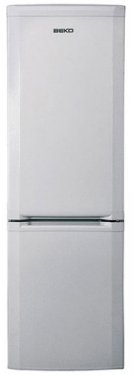
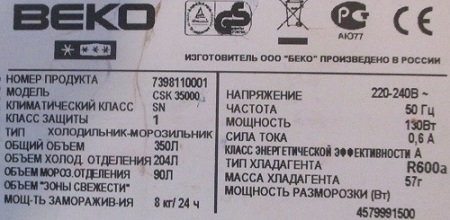
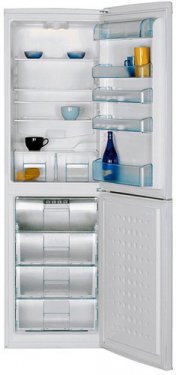
В состав холодильного агрегата входит: компрессор, конденсатор, статический испаритель морозильной камеры, «плачущий» испаритель холодильной камеры, фильтр-осушитель, капиллярный трубопровод. К плюсам конструкции можно вынесенный, не запененный конденсатор. К минусам – стальной контур подогрева периметра двери — наиболее вероятное возникновение утечек после 5 лет эксплуатации на участке трубопровода, труба жесткая не отоженная, микротрещины могут возникать уже при закладке трубы на конвейере. При эксплуатации температура на этом участке трубопровода достигает 90 С. 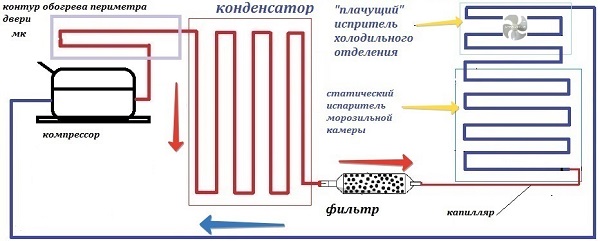
Мотор-компрессор откачивает пары фреона из испарителя и нагнетает их в конденсатор. В конденсаторе пары фреона охлаждаются и конденсируются. Далее жидкий фреон через фильтр-осушитель и капиллярный трубопровод попадает в испаритель морозильной камеры. Гидравлическое сопротивление капиллярного трубопровода подобрано таким образом, чтобы создать определенную разность давления всасывания и конденсации, которое создает компрессор, при которой через трубопровод проходило определенное количество жидкости. На входе фреона в испаритель, давление падает от давления конденсации до давления кипения. Этот процесс называется дросселированием. При этом происходит вскипание фреона, поступая в каналы испарителя, фреон кипит, энергия необходимая для кипения в виде тепловой, забирается от поверхности испарителя, охлаждая воздух в морозильной камере. При понижении температуры в морозильной камере фреон начинает кипеть в испарителе холодильной камеры, соединенным последовательно с испарителем МК. Пройдя через испаритель, жидкий фреон превращается в пар, который откачивается компрессором.
Продукты в морозильной камере охлаждаются статическим испарителем. Испаритель, представляет из себя змеевик, выполняющий и функцию полок МК. Оттаивание морозильной камеры – ручное. Хорошая теплоизоляция позволяет производить оттайку не чаще одного раза в год. Вода удаляется по каналу слива конденсата расположенного под испарителем в емкость сбора конденсата. Емкость закреплена на компрессоре холодильника, рабочая температура компрессора достигает 90 С. и вода быстро испаряется в окружающую среду.
морозильная камера холодильная камера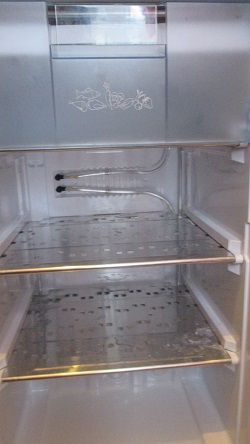
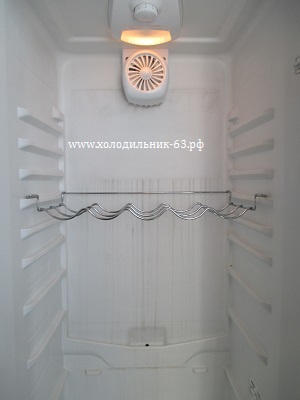
Продукты в холодильной камере охлаждаются испарителем ХК, находящимся за задней стенкой. Cистема вентиляции, гарантирует беспрерывное движение воздуха, а значит, однородное распределение температуры и оптимальной влажности внутри всего объема холодильной камеры. Холодные потоки распределяются равномерно по всему объему, обеспечивая идеальную температуру хранения продуктов. Кнопочный выключатель двери включает вентилятор и выключает свет при закрытии двери холодильной камеры, при открытии двери вентилятор останавливается.
Отключение компрессора при достижении температуры производится терморегулятором. Оттайка холодильной камеры автоматическая. При отключении компрессора температура испарителя до следующего замыкания контактов терморегулятора повышается до плюсовой, весь конденсат, вымерзший на задней стенке тает. Вода удаляется по каналу сбора слива конденсата, расположенного внизу на задней стенке ХК, в емкость сбора конденсата. Емкость закреплена на компрессоре холодильника, рабочая температура компрессора достигает 90 С.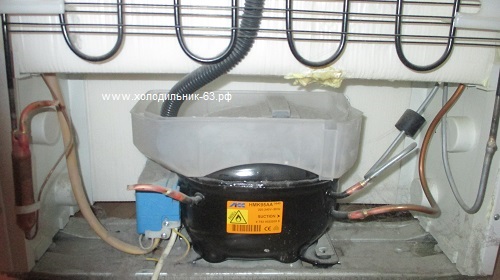
Дефекты![]()
-
1 2 3 4 5 6 7 8 9 10

